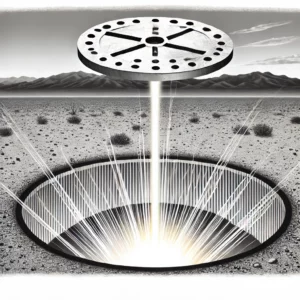When we think of the fastest man-made objects, we might imagine high-speed jets or rockets soaring through the atmosphere. However, the title of the fastest man-made object ever recorded belongs to an unlikely candidate: a steel manhole cover, launched by a nuclear test.
The Unlikely Record
In 1957, the United States conducted a series of nuclear tests known as “Operation Plumbbob” at the Nevada Test Site. One of these tests, named “Pascal-B,” involved detonating a nuclear device at the bottom of a 500-foot vertical shaft. This test was designed to study the effects of nuclear explosions, but it unintentionally set a remarkable record.
The Pascal-B Test
The Pascal-B test aimed to explore various nuclear explosion effects. The test shaft was sealed with a heavy steel plate cap, resembling a large manhole cover, to contain the explosion. When the nuclear device detonated, it generated an immense amount of energy, propelling the steel plate upwards with incredible force.
The Launch
The steel manhole cover was subjected to an unprecedented acceleration. Scientists estimated that the plate reached speeds of up to 150,000 miles per hour (240,000 kilometers per hour), which is roughly six times the escape velocity of Earth. The plate’s speed was so high that it was only captured on film for a single frame before it disappeared from view.
The Fate of the Manhole Cover
Given the extreme velocity and the intense heat generated by the friction with the atmosphere, it is widely believed that the manhole cover was vaporized shortly after launch. While it never reached space, the manhole cover’s brief flight remains one of the most extraordinary events in the history of nuclear testing.
Scientific and Historical Significance
The Pascal-B manhole cover’s story is more than just a quirky historical anecdote; it holds significant scientific interest. The event demonstrated the tremendous power of nuclear explosions and provided valuable data on the effects of such explosions on materials and structures. Additionally, it highlighted the sometimes-unexpected outcomes of experimental tests.

The tale of the fastest man-made object continues to captivate scientists, historians, and enthusiasts. It serves as a reminder of the extraordinary capabilities of human ingenuity and the surprising results that can emerge from scientific experimentation. The Operation Plumbbob manhole cover stands as a testament to the incredible speeds that can be achieved through the forces of nature and human engineering.
